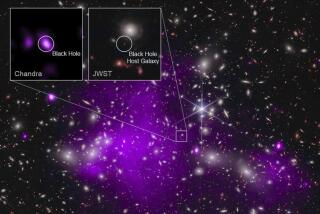Black Hole Lies at Center of Galaxy, Studies Indicate
- Share via
PHOENIX — Rapidly rotating red giant stars and a faint infrared glow have been discovered near the center of the Milky Way, supporting the hypothesis that an exotic black hole may lurk deep inside Earth’s otherwise undistinguished home galaxy, scientists said Tuesday.
After two decades of studying intense radio-wave emissions from a mysterious object called Sagittarius-A-Star, scientists had suspected it was a black hole. But confirmation, which could resolve differences among theorists about the nature of galaxies, awaited conclusive proof.
The new observations, reported at an American Astronomical Society meeting, provide some, but not all, of the information needed to prove the existence of a black hole--the theoretical remnant of a collapsed star so massive that not even light can escape its gravity.
One observation, made by a team of astronomers at the University of Arizona’s Steward Observatory, apparently found the “missing” infrared radiation that would be emitted by rapidly flowing gases being sucked into a black hole.
“A big argument against a black hole has been the absence of infrared emissions,” said Laird M. Close, on the researchers. “That is what we have found.”
The second observation, made by other University of Arizona astronomers, measured the speeds at which red giant stars near the center of the galaxy rotate around the galaxy’s core. They concluded that visible mass alone could not account for the gravity needed to propel the speeding suns; an unseen massive object, “probably a black hole,” had to be nearby.
The astronomers estimated that whatever is at the core of the Milky Way weighs from 900,000 to 1 million times as much as the sun, but could not rule out estimates by other scientists that range from 1,000 to 3 million solar masses.
Other scientists at the meeting called the new findings compelling but not conclusive.
“To have a black hole, you must have a very large mass in a very small dimension,” said Kwok-Yung Lo of the University of Illinois. “We have the small dimension, but we don’t have the (precise) mass. . . . The observations are very interesting, but we’re not there yet.”
Others, led by Apostolos Mastichiadis and Leonid Ozernoy of NASA’s Goddard Space Flight Center in Maryland, said the gamma- and X-ray emissions from Sagittarius-A-Star were too weak for a black hole 1 million times the mass of the sun. They said any black hole in the area is likely to be far smaller, about 1,000 solar masses.
Astronomers and astrophysicists are eager to determine the actual nature of Sagittarius-A-Star for several reasons. One is the opportunity to conclusively prove the existence of black holes. Another is the opportunity to study one relatively close up.
At the same time, the existence of a black hole at the center of the Milky Way, which scientists describe as little more than an anonymous resident in a suburb of the Virgo supercluster, suggests that it may once have been a more spectacular, star-spewing “active galaxy.”
That, in turn, would imply that very large black holes routinely lie at the cores of most ordinary galaxies.
If there is a black hole at the center of the Milky Way, at 28,000 light years from Earth it should be close enough to be seen by sophisticated telescopes. But astronomers are not likely to get a glimpse because too much interstellar gas and dust lie in the way.
Because of this, astronomers have relied on the longer waves of infrared and radio radiation, which can more easily penetrate the gas clouds.






